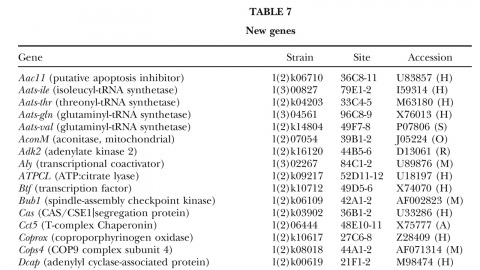Filter
Associated Lab
Publication Date
Type of Publication
2 Publications
Showing 1-2 of 2 resultsA fundamental goal of genetics and functional genomics is to identify and mutate every gene in model organisms such as Drosophila melanogaster. The Berkeley Drosophila Genome Project (BDGP) gene disruption project generates single P-element insertion strains that each mutate unique genomic open reading frames. Such strains strongly facilitate further genetic and molecular studies of the disrupted loci, but it has remained unclear if P elements can be used to mutate all Drosophila genes. We now report that the primary collection has grown to contain 1045 strains that disrupt more than 25% of the estimated 3600 Drosophila genes that are essential for adult viability. Of these P insertions, 67% have been verified by genetic tests to cause the associated recessive mutant phenotypes, and the validity of most of the remaining lines is predicted on statistical grounds. Sequences flanking >920 insertions have been determined to exactly position them in the genome and to identify 376 potentially affected transcripts from collections of EST sequences. Strains in the BDGP collection are available from the Bloomington Stock Center and have already assisted the research community in characterizing >250 Drosophila genes. The likely identity of 131 additional genes in the collection is reported here. Our results show that Drosophila genes have a wide range of sensitivity to inactivation by P elements, and provide a rationale for greatly expanding the BDGP primary collection based entirely on insertion site sequencing. We predict that this approach can bring >85% of all Drosophila open reading frames under experimental control.
Within all species of animals, the size of each organ bears a specific relationship to overall body size. These patterns of organ size relative to total body size are called static allometry and have enchanted biologists for centuries, yet the mechanisms generating these patterns have attracted little experimental study. We review recent and older work on holometabolous insect development that sheds light on these mechanisms. In insects, static allometry can be divided into at least two processes: (1) the autonomous specification of organ identity, perhaps including the approximate size of the organ, and (2) the determination of the final size of organs based on total body size. We present three models to explain the second process: (1) all organs autonomously absorb nutrients and grow at organ-specific rates, (2) a centralized system measures a close correlate of total body size and distributes this information to all organs, and (3) autonomous organ growth is combined with feedback between growing organs to modulate final sizes. We provide evidence supporting models 2 and 3 and also suggest that hormones are the messengers of size information. Advances in our understanding of the mechanisms of allometry will come through the integrated study of whole tissues using techniques from development, genetics, endocrinology and population biology.

